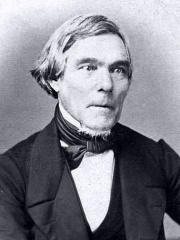
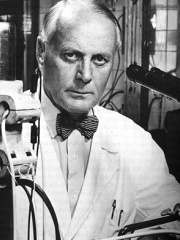
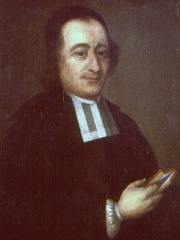
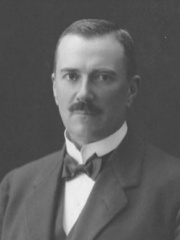
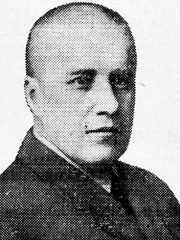

The Most Famous
PHYSICIANS from Finland
This page contains a list of the greatest Finnish Physicians. The pantheon dataset contains 726 Physicians, 7 of which were born in Finland. This makes Finland the birth place of the 23rd most number of Physicians behind Sweden, and Greece.
Top 7
The following people are considered by Pantheon to be the most legendary Finnish Physicians of all time. This list of famous Finnish Physicians is sorted by HPI (Historical Popularity Index), a metric that aggregates information on a biography's online popularity.

1. Elias Lönnrot (1802 - 1884)
With an HPI of 74.74, Elias Lönnrot is the most famous Finnish Physician. His biography has been translated into 64 different languages on wikipedia.
Elias Lönnrot (Finnish: [ˈeliɑs ˈlønruːt] ; 9 April 1802 – 19 March 1884) was a Finnish polymath, physician, philosopher, poet, musician, linguist, journalist, philologist and collector of traditional Finnish oral poetry. He is best known for synthesizing the Finnish national epic, Kalevala (1835, enlarged 1849) from short ballads and lyric poems he gathered from Finnish oral tradition during several field expeditions in Finland, Russian Karelia, the Kola Peninsula and Baltic countries. In botany, he is remembered as the author of the 1860 Flora Fennica, the first scientific text written in Finnish rather than in Latin.

2. Ragnar Granit (1900 - 1991)
With an HPI of 72.21, Ragnar Granit is the 2nd most famous Finnish Physician. His biography has been translated into 56 different languages.
Ragnar Arthur Granit (30 October 1900 – 12 March 1991) was a Finnish-Swedish scientist who was awarded the Nobel Prize in Physiology or Medicine in 1967 along with Haldan Keffer Hartline and George Wald "for their discoveries concerning the primary physiological and chemical visual processes in the eye".

3. Anders Chydenius (1729 - 1803)
With an HPI of 60.80, Anders Chydenius is the 3rd most famous Finnish Physician. His biography has been translated into 21 different languages.
Anders Chydenius (Finland Swedish: [ˈandærs tɕyˈdeːniʉs]; 26 February 1729 – 1 February 1803) was a Swedish-Finnish Lutheran priest and a member of the Swedish Riksdag, and is known as the leading classical liberal of Nordic history. He carried out his life's work in the Kingdom of Sweden, advocating for free trade, freedom of speech, and social reforms. Born in Sotkamo, Finland (then part of Sweden) and having studied under Pehr Kalm at the Royal Academy of Åbo (Turku), Chydenius became a priest and Enlightenment philosopher. He was elected as an ecclesiastic member of the Swedish Riksdag of the Estates in 1765–66, in which his Cap party seized the majority and government and championed Sweden's first Freedom of the Press Act, the most liberal in the world along with those of Great Britain and the Seven United Provinces (of the Netherlands). Vehemently opposed to the extreme interventionist policies of mercantilism preached by the previously predominant Hat party for decades, he was ultimately coerced into retirement for his criticism of the Cap administration's radical deregulation policies and their social and political consequences. Following Gustav III's coup d'état in 1772, which meant the end of parliamentary rule for another century, Chydenius briefly returned to prominence and worked to increase civil liberties and economic freedom as part of Gustav's doctrine of enlightened despotism, and contributed to the abolishment of torture as means of interrogation, the limitation of capital punishment, and the legalisation of Jewish and Catholic immigration into Sweden. Ultimately, the king's increasingly autocratic position brought Chydenius out of favour again, and he retired to private life in Ostrobothnia, where he died at age 73. An early pioneer—also by international standards—and proponent of economic liberalism, freedom of religion, freedom of speech and migration (writing a pamphlet on the invisible hand a decade before the publication of The Wealth of Nations) he was one of the first comprehensive philosophers of liberalism.

4. Erik Adolf von Willebrand (1870 - 1949)
With an HPI of 57.33, Erik Adolf von Willebrand is the 4th most famous Finnish Physician. His biography has been translated into 17 different languages.
Erik Adolf von Willebrand (1 February 1870 – 12 September 1949) was a Finnish physician who made major contributions to hematology. Von Willebrand disease and von Willebrand factor are named after him. He also researched metabolism, obesity and gout, and was one of the first Finnish physicians to use insulin to treat a diabetic coma. Von Willebrand qualified in medicine in 1896 from the University of Helsinki, where he received his Ph.D. in 1899. He worked at the University of Helsinki from 1900 until 1930. From 1908 until his retirement in 1933, he was the head of the department of medicine at the Deaconess Hospital in Helsinki, where he also was physician-in-chief from 1922 to 1931. In 1924, Von Willebrand was consulted about a young girl with a bleeding disorder. He described this disorder in 1926, distinguishing it from hemophilia. The disorder was named after him, becoming known as von Willebrand disease. The cause of the disease was later discovered to be a deficiency of a protein, now known as von Willebrand factor, that enables hemostasis.
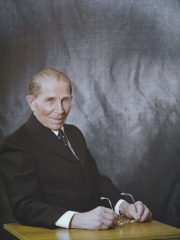
5. Arvo Ylppö (1887 - 1992)
With an HPI of 54.91, Arvo Ylppö is the 5th most famous Finnish Physician. His biography has been translated into 16 different languages.
Arvo Henrik Ylppö (27 October 1887 – 28 January 1992) was a Finnish physician and professor of pediatrics who significantly decreased Finnish infant mortality during the 20th century. He is credited as the father of Finland's public maternity and child health clinic system established in 1922 (Finnish: neuvola), which focuses on monitoring the health and development of newborn and pre-school children and their families, providing parents with childcare guidance and supporting child-parent interaction. For forty years, Ylppö held the title of archiater (arkkiatri), the highest honorary title awarded to a physician. Internationally, he was known for his research on premature infants. Ylppö was born in 1887 in Akaa, Finland into a farming family. He was apparently born premature and remained small in stature through his life. He entered the University of Helsinki in 1906 and decided to specialize in pediatric medicine. In 1912, he moved to the Imperial Children's Hospital in Berlin, Germany, where he wrote his thesis about infants' bilirubin metabolism in 1913. It was printed in Germany. He graduated as a medical doctor in March 1914 in Helsinki. While in Germany, Ylppö concentrated on research about children's pathological anatomy and attracted international recognition. In his research, he observed that deaths of prematurely born infants are usually due to treatable conditions rather than simple underdevelopment, which motivated advancement of treatment of and science related to prematurely born infants. After returning to Finland in 1920, he became a teacher at Helsinki University Hospital. In 1922, he established an advice centre for the care of young children in the Children's Castle (Lastenlinna) hospital, which is considered to be the beginning of child health clinics in Finland. In 1925, he became professor of pediatrics. Ylppö continued his research, wrote extensively to medical journals about child care. He supported efforts to expand Finnish nurse training, Finnish pharmacy industry, and public awareness about medical matters. He retired as a professor in 1957 but still sponsored many childcare initiatives. From 1920 to 1963, he was chief physician at the Children's Castle hospital. He also had a private practice in Helsinki. Arvo Ylppö died in January 1992 at the age of 104. He is buried in the Hietaniemi Cemetery in Helsinki.

6. Aarne Pohjonen (1886 - 1938)
With an HPI of 52.13, Aarne Pohjonen is the 6th most famous Finnish Physician. His biography has been translated into 15 different languages.
Aarne Anders Pohjonen (29 March 1886 – 22 December 1938) was a Finnish gymnast who won bronze in the 1908 Summer Olympics.

7. Silja Lehtinen (b. 1985)
With an HPI of 33.68, Silja Lehtinen is the 7th most famous Finnish Physician. Her biography has been translated into 14 different languages.
Silja Lehtinen (born 5 November 1985 in Helsinki) is a Finnish sailor. Silja Lehtinen has sailed in two Olympic regattas. In 2008, at the age of 23, she skippered the Finnish team in the Yngling class to an 11th place. In 2012, she participated in Women's Match Race (Elliott 6m) and won a bronze medal with her crew, Silja Kanerva and Mikaela Wulff. In 2012 as well, only a month before the Olympic regatta, Lehtinen and her crew won match race world championship title in Gothenburg, Sweden. Her brother Lauri skippered the Finnish 49er into seventh place at the 2012 Olympic regatta. As a 15 year old, she won the Byte class World Championship in 2001. Lehtinen studies medicine at the University of Helsinki.
People
Pantheon has 7 people classified as Finnish physicians born between 1729 and 1985. Of these 7, 1 (14.29%) of them are still alive today. The most famous living Finnish physicians include Silja Lehtinen. The most famous deceased Finnish physicians include Elias Lönnrot, Ragnar Granit, and Anders Chydenius. As of April 2024, 1 new Finnish physicians have been added to Pantheon including Silja Lehtinen.
Living Finnish Physicians
Go to all RankingsDeceased Finnish Physicians
Go to all RankingsElias Lönnrot
1802 - 1884
HPI: 74.74
Ragnar Granit
1900 - 1991
HPI: 72.21
Anders Chydenius
1729 - 1803
HPI: 60.80
Erik Adolf von Willebrand
1870 - 1949
HPI: 57.33
Arvo Ylppö
1887 - 1992
HPI: 54.91
Aarne Pohjonen
1886 - 1938
HPI: 52.13
Newly Added Finnish Physicians (2025)
Go to all RankingsOverlapping Lives
Which Physicians were alive at the same time? This visualization shows the lifespans of the 6 most globally memorable Physicians since 1700.

